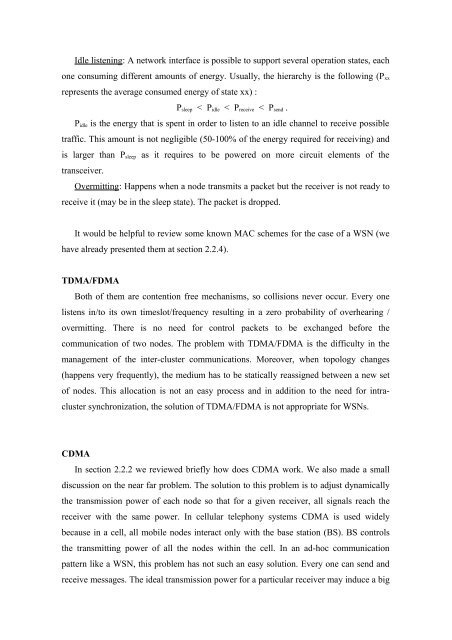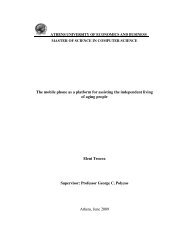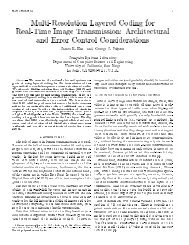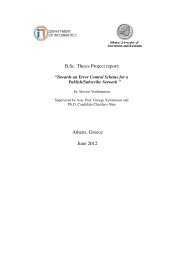In Network Processing and Data Aggregation in
In Network Processing and Data Aggregation in
In Network Processing and Data Aggregation in
You also want an ePaper? Increase the reach of your titles
YUMPU automatically turns print PDFs into web optimized ePapers that Google loves.
Idle listen<strong>in</strong>g: A network <strong>in</strong>terface is possible to support several operation states, eachone consum<strong>in</strong>g different amounts of energy. Usually, the hierarchy is the follow<strong>in</strong>g (P xxrepresents the average consumed energy of state xx) :P sleep < P idle < P receive < P send .P idle is the energy that is spent <strong>in</strong> order to listen to an idle channel to receive possibletraffic. This amount is not negligible (50-100% of the energy required for receiv<strong>in</strong>g) <strong>and</strong>is larger than P sleep as it requires to be powered on more circuit elements of thetransceiver.Overmitt<strong>in</strong>g: Happens when a node transmits a packet but the receiver is not ready toreceive it (may be <strong>in</strong> the sleep state). The packet is dropped.It would be helpful to review some known MAC schemes for the case of a WSN (wehave already presented them at section 2.2.4).TDMA/FDMABoth of them are contention free mechanisms, so collisions never occur. Every onelistens <strong>in</strong>/to its own timeslot/frequency result<strong>in</strong>g <strong>in</strong> a zero probability of overhear<strong>in</strong>g /overmitt<strong>in</strong>g. There is no need for control packets to be exchanged before thecommunication of two nodes. The problem with TDMA/FDMA is the difficulty <strong>in</strong> themanagement of the <strong>in</strong>ter-cluster communications. Moreover, when topology changes(happens very frequently), the medium has to be statically reassigned between a new setof nodes. This allocation is not an easy process <strong>and</strong> <strong>in</strong> addition to the need for <strong>in</strong>traclustersynchronization, the solution of TDMA/FDMA is not appropriate for WSNs.CDMA<strong>In</strong> section 2.2.2 we reviewed briefly how does CDMA work. We also made a smalldiscussion on the near far problem. The solution to this problem is to adjust dynamicallythe transmission power of each node so that for a given receiver, all signals reach thereceiver with the same power. <strong>In</strong> cellular telephony systems CDMA is used widelybecause <strong>in</strong> a cell, all mobile nodes <strong>in</strong>teract only with the base station (BS). BS controlsthe transmitt<strong>in</strong>g power of all the nodes with<strong>in</strong> the cell. <strong>In</strong> an ad-hoc communicationpattern like a WSN, this problem has not such an easy solution. Every one can send <strong>and</strong>receive messages. The ideal transmission power for a particular receiver may <strong>in</strong>duce a big








